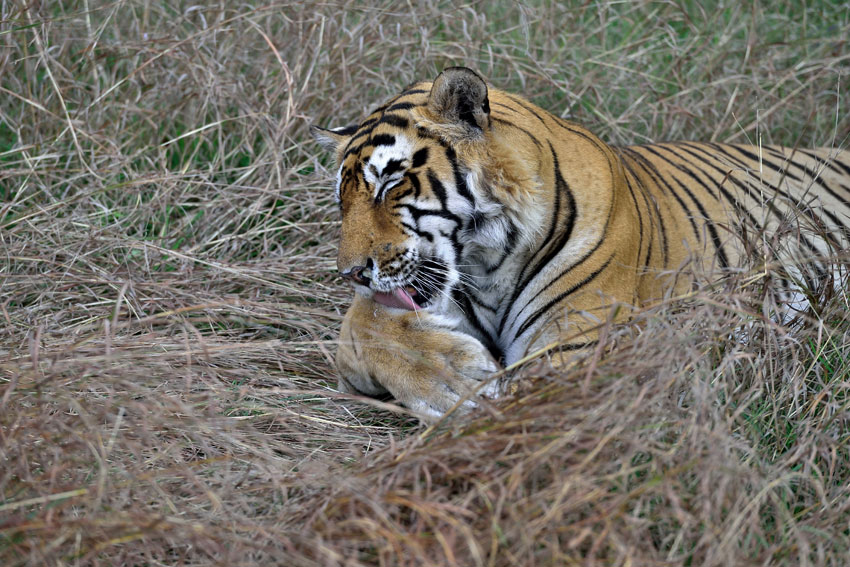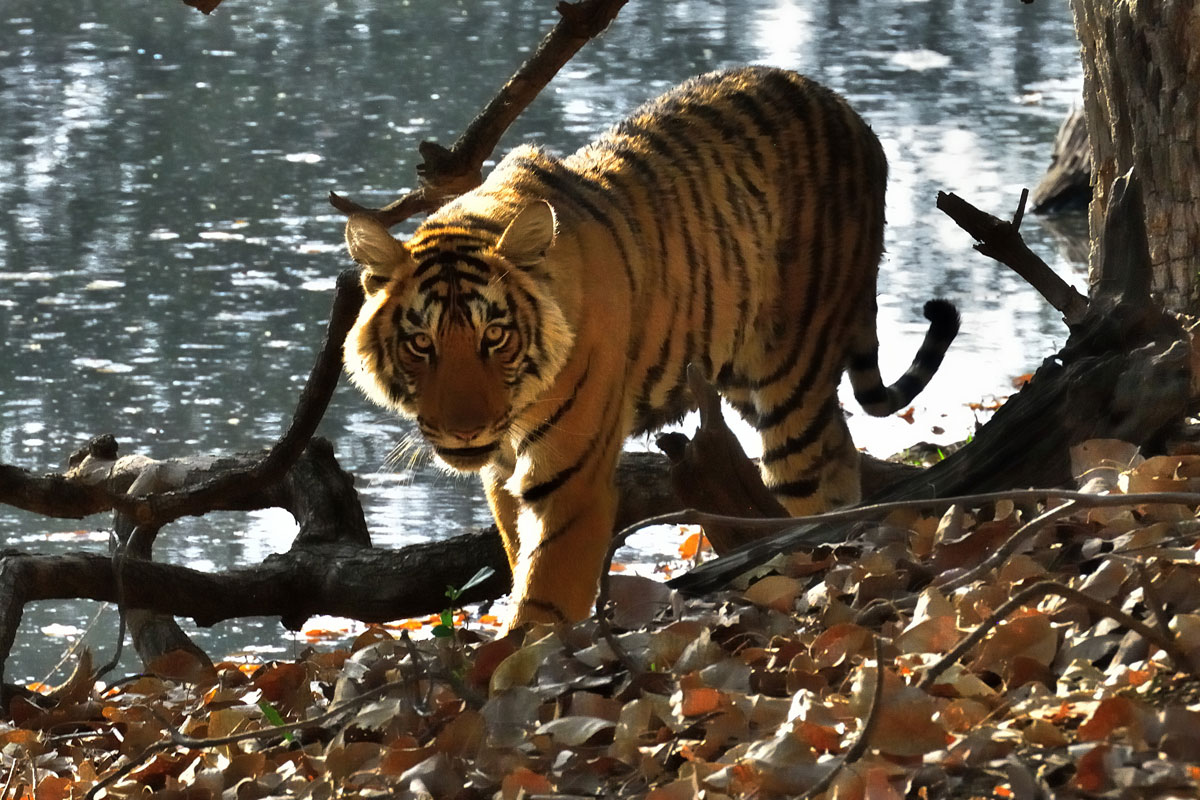HANGING AROUND DEPLETED HABITATS
A tiger at the Ranthambore National Park in India.
Nine-year-old “Ustaad” alias “T24” is the center of attention of wildlife lovers, enthusiasts, activists and the media. The reason being the state forest authorities have relocated the tiger, the most spotted one in the reserve, from the Ranthambore National Park in the desert state of Rajasthan to a zoo in another city called Udaipur situated about 500 kilometers away, writes Priyanka Bhardwaj.
Forest officials hold T24 guilty of killing a forest guard and three more persons, all in the first week of May.
Fans of tigers, however, do not accept this charge and have taken it up with the government and courts.
Defenses offered for “Ustaad” are: “Where is the evidence of all the attacks? It is just a conjecture. The tiger may be aggressive, but is not a habitual predator of humans. The forest guard was killed in the innermost part of the jungle and not in any inhabited area. And if he did attack, then it must be out of fear. But all this does not qualify him as a man-eater?”
A wildlife lover, D. Sanjay says, “Tourists have taken photographs of him. If it was suspected that he was a man-eater how were they allowed to come so close?”
Conservation experts demand that the tiger be moved back from captivity to the jungles albeit to a different territory or else it might set a dangerous precedent.
Supporters of Ustaad first went on to social and online networking sites like Change.org and Twitter where hashtags like #BringT24back with tweets such as, “What the hell is happening in #Ranthambhore?? They have shifted tiger T-24 to a zoo from the jungle,” were trending.
Then the protests took the form of candle light vigils in numerous cities across the country.
Finally Pune-based Chandra Bhal Singh filed a Special Leave Petition at the Supreme Court.
On a telecon Singh reasoned, “We moved the Delhi High Court on Monday, which asked us to move the Rajasthan High Court. The Rajasthan HC listed our petition for May 28. But we thought it would be too late for the tiger. So we moved the apex court. We have faith in the judiciary and feel there will be justice to Ustaad.”
As matters stand, a bench led by Justice A.K. Sikri has ordered a status quo with respect to shifting of the tiger till the High Court takes a decision.
The High Court hearing is slated for May 28.
At present T24 is at the 10,000 square feet enclosure at Sajjangarh Biological Park in Udaipur.
It is believed that forest authorities took the decision to shift T24 to the zoo under the pressure of the tourism lobby thriving around the reserve, and without intimating the state forest minister, Raj Kumar Rinwa, on the issue.
The norm has been to take advantage of the huge expanse of a reserve and shift a predator to another or inner zone like in the instance of a certain tiger in Corbet Park that was accorded a re-location from its territory where it mauled a forest guard to a distant one.
Ranthambore forest officials are adamant that their decision to shift Ustaad to Udaipur zoo is all for the safety of visitors and staff.
Forest guides at the reserve inform that though tigers are known to operate in their territories they sometimes tend to mark others also.
Lately T57, another tiger, has been trying to mark T24’s territory, and with T24 not around, the survival of T24’s three cubs is also endangered.
Of special interest is the dry deciduous and open-grassy Ranthambore National Reserve as it is the largest in North India, 392 square kilometers in area and as per a 2014 tiger-census home to 62 big cats.
Littered with large lakes, the reserve lies at the junction of the Aravalli and Vindhya ranges and is a wildlife enthusiast and photographer’s dream.
Not many summers back, in 2004, the Sariska Tiger Reserve was declared void of tigers, thanks mainly to human interference and poaching and partly due to vehicular traffic and illegal grazing of cattle of villagers residing in peripheral zones of the sanctuary.
It was in 2008 that Ranthambore Park, home to 34 adult tigers and 14 cubs, participated in the relocation program to transfer some to Sariska.
The pride of Ranthambore Reserve has always been grabbing global eyeballs.
The super star of the lot is 18-years-old “The Lay of the Lakes” or “Machchli,” the world’s oldest and most photographed tigress, whose epic fight with a crocodile was a one of its kind in the history of wildlife.

More than half of Ranthambore and Sariska’s reserves are of Machchli’s lineage as she has given birth to four males and five females in her lifetime.
But when it comes to bringing back tigers from the brink of extinction, the government does not seem to have learnt any lessons.
It is learnt that the National Highway Authority of India has ordered the construction of a new highway, NH 248A, passing through the buffer zone of Ranthambore.
On being questioned, the locals and state forest authorities simply shift the onus of this decision to the highway body.
Similar stories speak of laxity and callousness in any conservation effort in a country that boasts of a speeding economy but cannot provide with flawless techniques to safeguard less than 3,000 big cats, 70 percent of the total world figure.
Though the official count is said to have increased by 30 percent since 2010, yet their state is pitiable and they land up being counted, confined and cured of ailments at the will and mercy of the brutal civil human world.
And counting too is conducted by inaccurate and unscientific census models complain conservation scientists.
In the last two centuries a rapid deterioration in size and quality of natural habitat has driven the wild animals to hang on to their dear lives.
An illustration of what the big cats mean to us is found in the protection of the 4,000 square miles of mangrove habitat of Sunderbans in India and Bangladesh from deforestation.
These mangroves occupying regions in India and Bangladesh act as a vital carbon sink and natural buffer against increasingly intense cyclones and storm surges.
Local conservationist Anil Biswas based out of Kolkata says that about a 100 of these fearsome cats ensure the ecosystem stays intact by preventing people from penetrating further into the jungles.
If nature is left untouched it does find ways of preserving eco-repositories from complete destruction.


